Also Known As:
Cerro de la Campana
and Suchilquitongo.
San Pablo Huitzo, Oaxaca, Mexico.
Travel & Tour
Photos, Pictures, Information, Images, & Reviews.
George & Eve DeLange
Google Map To The Huijazoo Archaeological Ruins
Also Known As: Cerro de la Campana and Suchilquitongo.
San Pablo Huitzo, Oaxaca, Mexico, Mexico.
View Larger Map
We Are Proud Of Our SafeSurf Rating!
Click On Any Of The Following Links By Amazon.Com
For Books Or Videos About The Zapotec People, In Mexico. No Obligation!
Huijazoo Archaeological Ruins, Also Known As: Cerro de la Campana and Suchilquitongo.
Located at, San Pablo Huitzo, Oaxaca, Mexico. San Pablo Huitzo is located 19 miles (31 kilometres) Northwest of the City of Oaxaca via highway 190 to Mexico City. Approximate travel time is 0:35 minutes. San Pablo Huitzo
has a small musem of Pre-Hispanic pieces and colonial religious art.
The following information concerning the tomb number five at Huijazoo comes from: Restoration of Tomb No. 5 of Huijazoo; by Veronica Fernandez de Castro; a paper presented at the 1989 WAAC Annual Meeting in Honolulu, Hawaii.
"The Tomb of Huijazoo dates from the Classical Period of the Zapotec culture (650-900 BC). It is located 29 kilometers to the north of the city of Oaxaca, now the capital of the State, in Etla Valley which is part of the municipality of Suchilquitongo. To arrive at the site one must cross the town of Suchilquitongo, and travel down two kilometers of narrow road, then continue on foot for the next 60 meters. At the site there is an esplanade made up of three mounds. The middle one is the principal pyramid, with a stone cross on the top where the people of the nearby town venerate their patron saint every year. On the right side of this mound is another which is as yet unexplored. On the left there is another small mound and under this one we find the tomb. The entrance is strategically placed: all approaching roads can be clearly seen.
The tomb is located under the mound at a depth of five meters. Access is by way of stucco-covered steps. The entrance was blocked by a large stone which has been removed.
Above the lintel there is a large stucco-covered mask worked in high relief, which is said to be the face of a snake with open jaws, from which the face of a red bird with large eyes emerges.
Following this there are two antechambers: the first is made up of two narrow niches where there are some designs of a red-orange coloring, but most designs have been lost; the second antechamber consists of two niches with three polychromatic walls representing various human figures.
On the north wall of the west niche, one can see a complete figure, totally dressed, which appears to be a priestess. She is wearing green and ocher earflaps, an elaborate headdress with rich plumage, and a dark red and white huipil. In her right hand she holds a green, orange and brown copal bag, the complete design outlined in black. In this room there are four lintels covered in stucco, in the center of each is a square painted red. Above the north lintel there is a large mask worked in high relief which is said to be the face of a jaguar with open jaws, wearing an elaborate headdress with geometric designs. From the jaws of the jaguar emerges the face and arms of a figure resembling a bat. These lintels rest upon stone blocks called jambs. There are ten jambs, each carved in bas relief, of distinctive figures with detailed vestments, painted red.
The floor of the tomb, as well as the steps to the funerary chamber, are made of stucco-covered earth. The funerary chamber consists of three walls, the east and west divided horizontally by a white line. The base of the walls is red- orange and the upper part shows a procession of human figures. All the figures wear headdresses of green feathers, as well as light brown dresses, pectoral plates and sandals. The faces of each have different expressions. Some of the figures have lost part of their detail and coloring. The lower level of the walls shows human figures of a different type, larger than those of the upper level, and their faces are those of animals such as jaguar and snakes. Their vestments are similar, consisting of a short skirt, bead necklaces, earflaps, and in one hand they carry a copal bag, while in the other they hold a stylized flower. All of the figures are facing north.
The north wall is the smallest, and has the fewest images. One can make out some green feathers and the remains of painted faces. In the central and highest part of the wall there is a small niche.
A stele decorated in bas relief was found in this room. It is divided in two parts: on the upper part there are two human figures, a young man with a skirt and bare torso, and in front of him an older man wearing an elaborate headdress, sitting in a position of higher rank. In front of this second figure there is a glyph of the long-nosed god wearing earflaps and a necklace, as well as a number glyph representing thirteen monkeys. On the lower part of the stele are the figures of a woman and an old man.
In the interior of the tomb various clay urns and vessels were found, as well as the skeletal remains of a young man. The peaked roof is made of large stone blocks, and the spaces between these are filled in with small stones and earth. The type of stone used to make the tomb can be found near the site and continues to be used by local people for construction."
Our guide and driver, Adan Fernando Castaneda, drove us to the foot of the hill that the ruins are located on without much effort. The road was blocked at the base of the hill with large stones laid in place so that we could not go any further by car. We then walked the last 60 meters up the hill to the ruins. Adan walked and sometimes ran ahead of us to show us the easiest way up the hill. We are certainly grateful to him for his assistance.
Since George is an astronomer and has been one for over thirty five years, he always is looking for astronomical alignments. One unusual alignment that he noticed is that the entire plan of this city seems to be on a very different alignment than most of the cities in Mesoamerica. It seems to be aligned on a SE to NW alignment. Since we were only there for about 45 minutes, we were unable to perform much of a study of the alignment and we would like to see further work on this hypothesis. We suspect that the alignment may have been to the solstices rather than to equinox alignments as most of the Mesoamerican cities show.
Tomb Number Five is closed to the public due to the fragile nature of the paintings contained within. You can only enter with permission of INAH. The tomb is locked and sealed at this time. We have seen photos of the paintings and they are probably the best preserved in Mesoamerica.
This site is mostly unexcavated, you will see many pyramids and structures including a ballcourt that are pretty much as they are found without any disturbance to them. If you are the Indiana Jone's type, you will enjoy the site.
If you are in the area we recommend this site to visit. You will probably be the only visitors on site.
Click On Any Of The Following Links By Amazon.Com
For Books Or Videos About Oaxaca Mexico. No Obligation!
The Xoxocotl�n International airport (IATA: OAX, ICAO: MMOX) Is the international airport located at Oaxaca, Oaxaca, Mexico. It handles the national and international air traffic for the city of Oaxaca.
We have links on this page that will connect you with flights into and out of the Xoxocotl�n International airport and allow you to book any of several of the best hotels in Oaxaca.
We suggest getting a hotel and then letting them arrange either a car or a tour of Oaxaca. If you call their Concierge Services ahead of your arrival, all of this can be pre-arranged for you.
We do this all the time, when traveling in Mexico. It is safe and it works!!! We have never experienced a problem, doing it this way!
We have placed links to Priceline.com on this page so you can arrange your flights into and out of Oaxaca; as well as your hotel, when visiting this area. We found that generally speaking, they provide the best hotel and air flight prices into Oaxaca.
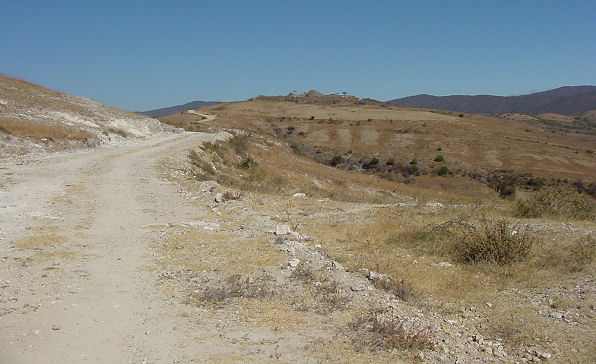
Huijazoo Archaeological Ruins.
About Two Kilometers From Church At Suchilquitongo.
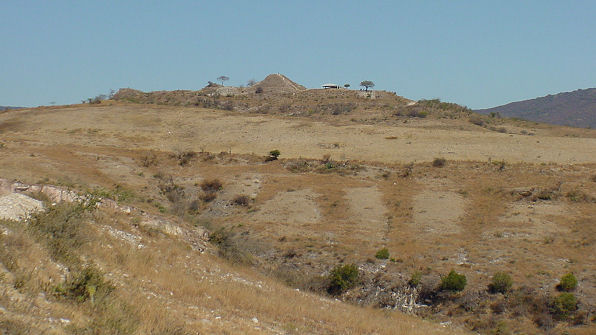
Huijazoo Archaeological Ruins Oaxaca Mexico, Looking North.
What Appears To Be A Hill In The Ruins Is A Pyramid!
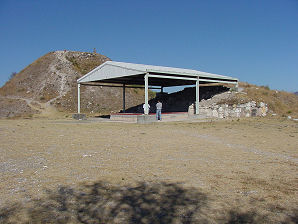
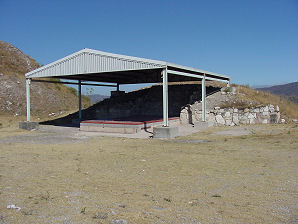
Audrey DeLange At
Tomb Number Five
At Huijazoo. Tomb No. 5.
Of Huijazoo. 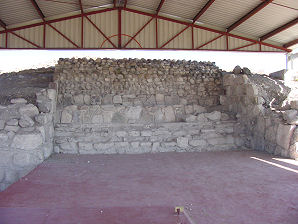
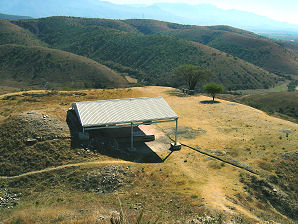
Tomb Number Five.
At Huijazoo. Tomb Number Five.
At Huijazoo. 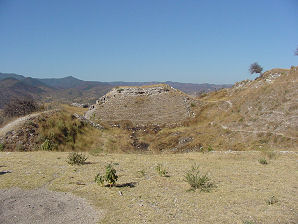
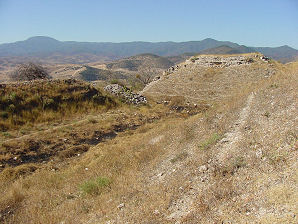
Small Pyramid
From Top Of Another
Ballcourt Appears
To Be Between. Another
View Of Ballcourt. 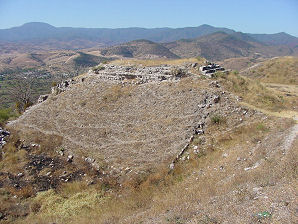
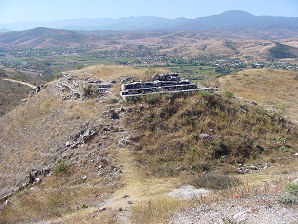
Pyramid. Another Pyramid. 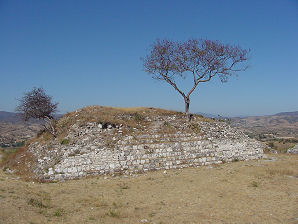
Unexcavated Temple. Unexcavated Temple. 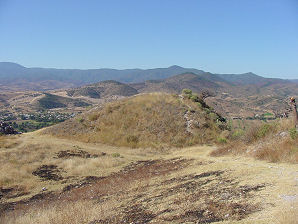
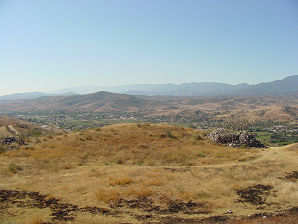
Unexcavated Temple. Unexcavated Temple. 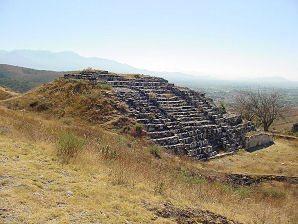
Unexcavated Temple. Unexcavated Temple. 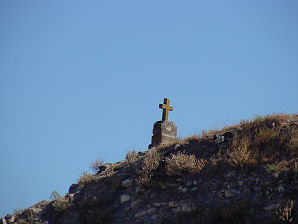
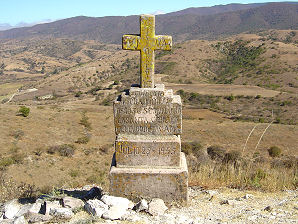
Note: Cross On
Top Of Pyramid. Christian Cross
Erected 1945. 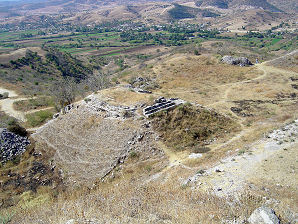
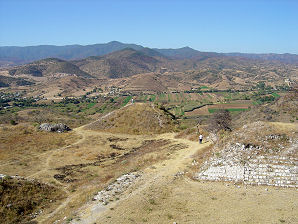
Pyramid. Pyramids. 
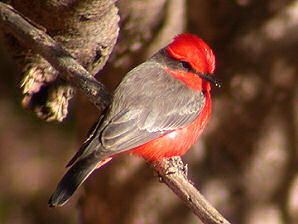
Patio. Vermilion Flycatcher.
Pyrocephalus rubinus.
Huijazoo Archaeological Ruins.
We Are Proud Of Our SafeSurf Rating!
Click On Any Of The Following Links By Amazon.Com
For Books Or Videos About Touring In Mexico. No Obligation!
Click On The Bottom Link Marked GO, Then Look At The Bottom Of The Page That Comes Up.
There You Will See Travel Agencies That Are Recommended By Amazon.Com
For Touring In Mexico. No Obligation!
Here Are Some Links To The Very Best & Most Popular Items Sold On Amazon.Com
To Learn More! Click The Links Below. No Obligation, Of Course!
Other Oaxaca Region Ruins & Attractions!
Huijazoo Archaeological Ruins, Also Known As: Cerro de la Campana and Suchilquitongo. Located at, San Pablo Huitzo, Oaxaca, Mexico. San Pablo Huitzo is located 19 miles (31 kilometres) Northwest of the City of Oaxaca via highway 190 to Mexico City. Approximate travel time is 0:35 minutes. San Pablo Huitzo has a small musem of Pre-Hispanic pieces and colonial religious art. The following information concerning the tomb number five at Huijazoo comes from: Restoration of Tomb No. 5 of Huijazoo; by Veronica Fernandez de Castro; a paper presented at the 1989 WAAC Annual Meeting in Honolulu, Hawaii. "The Tomb of Huijazoo dates from the Classical Period of the Zapotec culture (650-900 BC). It is located 29 kilometers to the north of the city of Oaxaca, now the capital of the State, in Etla Valley which is part of the municipality of Suchilquitongo. To arrive at the site one must cross the town of Suchilquitongo, and travel down two kilometers of narrow road, then continue on foot for the next 60 meters. At the site there is an esplanade made up of three mounds. The middle one is the principal pyramid, with a stone cross on the top where the people of the nearby town venerate their patron saint every year. On the right side of this mound is another which is as yet unexplored. On the left there is another small mound and under this one we find the tomb. The entrance is strategically placed: all approaching roads can be clearly seen. The tomb is located under the mound at a depth of five meters. Access is by way of stucco-covered steps. The entrance was blocked by a large stone which has been removed. Above the lintel there is a large stucco-covered mask worked in high relief, which is said to be the face of a snake with open jaws, from which the face of a red bird with large eyes emerges. Following this there are two antechambers: the first is made up of two narrow niches where there are some designs of a red-orange coloring, but most designs have been lost; the second antechamber consists of two niches with three polychromatic walls representing various human figures. On the north wall of the west niche, one can see a complete figure, totally dressed, which appears to be a priestess. She is wearing green and ocher earflaps, an elaborate headdress with rich plumage, and a dark red and white huipil. In her right hand she holds a green, orange and brown copal bag, the complete design outlined in black. In this room there are four lintels covered in stucco, in the center of each is a square painted red. Above the north lintel there is a large mask worked in high relief which is said to be the face of a jaguar with open jaws, wearing an elaborate headdress with geometric designs. From the jaws of the jaguar emerges the face and arms of a figure resembling a bat. These lintels rest upon stone blocks called jambs. There are ten jambs, each carved in bas relief, of distinctive figures with detailed vestments, painted red. The floor of the tomb, as well as the steps to the funerary chamber, are made of stucco-covered earth. The funerary chamber consists of three walls, the east and west divided horizontally by a white line. The base of the walls is red- orange and the upper part shows a procession of human figures. All the figures wear headdresses of green feathers, as well as light brown dresses, pectoral plates and sandals. The faces of each have different expressions. Some of the figures have lost part of their detail and coloring. The lower level of the walls shows human figures of a different type, larger than those of the upper level, and their faces are those of animals such as jaguar and snakes. Their vestments are similar, consisting of a short skirt, bead necklaces, earflaps, and in one hand they carry a copal bag, while in the other they hold a stylized flower. All of the figures are facing north. The north wall is the smallest, and has the fewest images. One can make out some green feathers and the remains of painted faces. In the central and highest part of the wall there is a small niche. A stele decorated in bas relief was found in this room. It is divided in two parts: on the upper part there are two human figures, a young man with a skirt and bare torso, and in front of him an older man wearing an elaborate headdress, sitting in a position of higher rank. In front of this second figure there is a glyph of the long-nosed god wearing earflaps and a necklace, as well as a number glyph representing thirteen monkeys. On the lower part of the stele are the figures of a woman and an old man. In the interior of the tomb various clay urns and vessels were found, as well as the skeletal remains of a young man. The peaked roof is made of large stone blocks, and the spaces between these are filled in with small stones and earth. The type of stone used to make the tomb can be found near the site and continues to be used by local people for construction." Our guide and driver, Adan Fernando Castaneda, drove us to the foot of the hill that the ruins are located on without much effort. The road was blocked at the base of the hill with large stones laid in place so that we could not go any further by car. We then walked the last 60 meters up the hill to the ruins. Adan walked and sometimes ran ahead of us to show us the easiest way up the hill. We are certainly grateful to him for his assistance. Since George is an astronomer and has been one for over thirty five years, he always is looking for astronomical alignments. One unusual alignment that he noticed is that the entire plan of this city seems to be on a very different alignment than most of the cities in Mesoamerica. It seems to be aligned on a SE to NW alignment. Since we were only there for about 45 minutes, we were unable to perform much of a study of the alignment and we would like to see further work on this hypothesis. We suspect that the alignment may have been to the solstices rather than to equinox alignments as most of the Mesoamerican cities show. Tomb Number Five is closed to the public due to the fragile nature of the paintings contained within. You can only enter with permission of INAH. The tomb is locked and sealed at this time. We have seen photos of the paintings and they are probably the best preserved in Mesoamerica. This site is mostly unexcavated, you will see many pyramids and structures including a ballcourt that are pretty much as they are found without any disturbance to them. If you are the Indiana Jone's type, you will enjoy the site. If you are in the area we recommend this site to visit. You will probably be the only visitors on site.
|
Click On Any Of The Following Links By Amazon.Com
For Books Or Videos About Oaxaca Mexico. No Obligation!
The Xoxocotl�n International airport (IATA: OAX, ICAO: MMOX) Is the international airport located at Oaxaca, Oaxaca, Mexico. It handles the national and international air traffic for the city of Oaxaca.
We have links on this page that will connect you with flights into and out of the Xoxocotl�n International airport and allow you to book any of several of the best hotels in Oaxaca.
We suggest getting a hotel and then letting them arrange either a car or a tour of Oaxaca. If you call their Concierge Services ahead of your arrival, all of this can be pre-arranged for you.
We do this all the time, when traveling in Mexico. It is safe and it works!!! We have never experienced a problem, doing it this way!
We have placed links to Priceline.com on this page so you can arrange your flights into and out of Oaxaca; as well as your hotel, when visiting this area. We found that generally speaking, they provide the best hotel and air flight prices into Oaxaca.

Huijazoo Archaeological Ruins.
About Two Kilometers From Church At Suchilquitongo.

Huijazoo Archaeological Ruins Oaxaca Mexico, Looking North.
What Appears To Be A Hill In The Ruins Is A Pyramid!


Audrey DeLange At
Tomb Number Five
At Huijazoo. Tomb No. 5.
Of Huijazoo. 

Tomb Number Five.
At Huijazoo. Tomb Number Five.
At Huijazoo. 

Small Pyramid
From Top Of Another
Ballcourt Appears
To Be Between. Another
View Of Ballcourt. 

Pyramid. Another Pyramid. 
Unexcavated Temple. Unexcavated Temple. 

Unexcavated Temple. Unexcavated Temple. 
Unexcavated Temple. Unexcavated Temple. 

Note: Cross On
Top Of Pyramid. Christian Cross
Erected 1945. 

Pyramid. Pyramids. 

Patio. Vermilion Flycatcher.
Pyrocephalus rubinus.
Huijazoo Archaeological Ruins.
We Are Proud Of Our SafeSurf Rating!
Click On Any Of The Following Links By Amazon.Com
For Books Or Videos About Touring In Mexico. No Obligation!
Click On The Bottom Link Marked GO, Then Look At The Bottom Of The Page That Comes Up.
There You Will See Travel Agencies That Are Recommended By Amazon.Com
For Touring In Mexico. No Obligation!
Here Are Some Links To The Very Best & Most Popular Items Sold On Amazon.Com
To Learn More! Click The Links Below. No Obligation, Of Course!
Other Oaxaca Region Ruins & Attractions!
The Xoxocotl�n International airport (IATA: OAX, ICAO: MMOX) Is the international airport located at Oaxaca, Oaxaca, Mexico. It handles the national and international air traffic for the city of Oaxaca. We have links on this page that will connect you with flights into and out of the Xoxocotl�n International airport and allow you to book any of several of the best hotels in Oaxaca. We suggest getting a hotel and then letting them arrange either a car or a tour of Oaxaca. If you call their Concierge Services ahead of your arrival, all of this can be pre-arranged for you. We do this all the time, when traveling in Mexico. It is safe and it works!!! We have never experienced a problem, doing it this way! We have placed links to Priceline.com on this page so you can arrange your flights into and out of Oaxaca; as well as your hotel, when visiting this area. We found that generally speaking, they provide the best hotel and air flight prices into Oaxaca.
|
 |
| Huijazoo Archaeological Ruins. About Two Kilometers From Church At Suchilquitongo. |
|---|
 |
| Huijazoo Archaeological Ruins Oaxaca Mexico, Looking North. What Appears To Be A Hill In The Ruins Is A Pyramid! |
|---|
 |  |
| Audrey DeLange At Tomb Number Five At Huijazoo. | Tomb No. 5. Of Huijazoo. |
|---|---|
 |  |
| Tomb Number Five. At Huijazoo. | Tomb Number Five. At Huijazoo. |
 |  |
| Small Pyramid From Top Of Another Ballcourt Appears To Be Between. | Another View Of Ballcourt. |
 |  |
| Pyramid. | Another Pyramid. |
 | |
| Unexcavated Temple. | Unexcavated Temple. |
 |  |
| Unexcavated Temple. | Unexcavated Temple. |
 | |
| Unexcavated Temple. | Unexcavated Temple. |
 |  |
| Note: Cross On Top Of Pyramid. | Christian Cross Erected 1945. |
 |  |
| Pyramid. | Pyramids. |
 |  |
| Patio. | Vermilion Flycatcher. Pyrocephalus rubinus. Huijazoo Archaeological Ruins. |
We Are Proud Of Our SafeSurf Rating!
Click On Any Of The Following Links By Amazon.Com
For Books Or Videos About Touring In Mexico. No Obligation!
Click On The Bottom Link Marked GO, Then Look At The Bottom Of The Page That Comes Up.
There You Will See Travel Agencies That Are Recommended By Amazon.Com
For Touring In Mexico. No Obligation!
Here Are Some Links To The Very Best & Most Popular Items Sold On Amazon.Com
To Learn More! Click The Links Below. No Obligation, Of Course!
Other Oaxaca Region Ruins & Attractions!
There You Will See Travel Agencies That Are Recommended By Amazon.Com
For Touring In Mexico. No Obligation!
Here Are Some Links To The Very Best & Most Popular Items Sold On Amazon.Com
To Learn More! Click The Links Below. No Obligation, Of Course!
Other Oaxaca Region Ruins & Attractions!



